How Long Does It Take for Baby to Adjust to Formula Change
"My baby won't take a bottle," are words that have come out of my own mouth, and boy was it stressful. Get 11 incredible tips to help your breastfed baby take a bottle. Plus, the best bottles for breastfed babies.
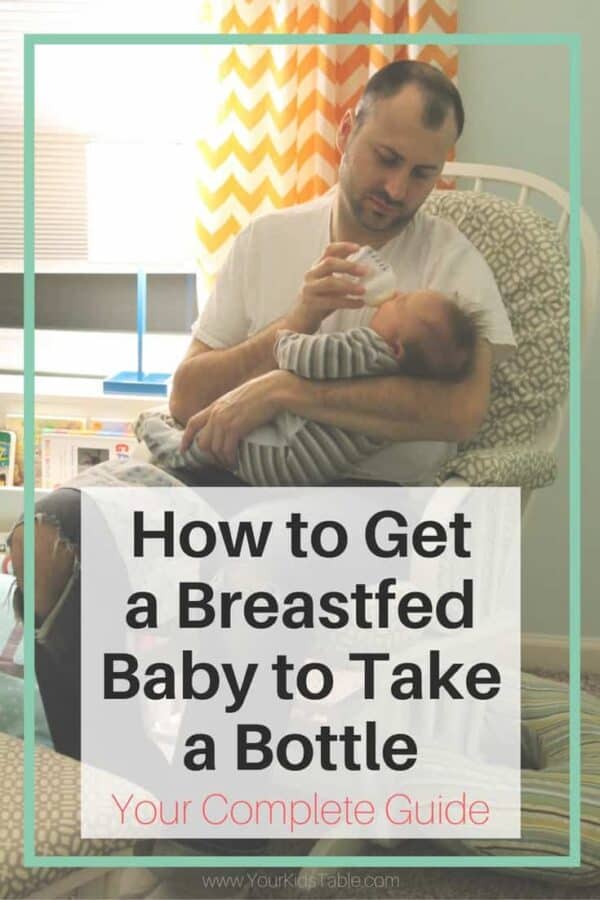
What to Do When Baby Won't Take A Bottle!
I can still remember the stress, anxiety, and absolute overwhelm when I was a mother for the first time 7 years ago and I realized: my baby won't take a bottle.
Before Sam's arrival, I was both excited and nervous to breastfeed. I'm a pediatric occupational therapist and already knew a thing or two about feeding babies.
But, because I'm type A, I read everything I could from a mother's perspective to make sure I did everything "right". I felt like there were endless stories from everyone around me that breastfeeding just didn't end up working out for them.
That was the last thing I wanted, so with my first child, I followed all the rules and was so relieved when it was obvious very early on that he was going to have no trouble nursing at all. What I didn't expect was that my sweet little breastfeeding champ would refuse to take a bottle for 12 months, which was the entirety of our nursing relationship.
I'll admit that, at some point, I stopped trying and lived with crazy work schedules and feeling completely helpless.
I've learned a lot since then, I had two more kids that DID take bottles and could switch between being bottle fed and nursing just fine, as long as I wasn't around.
Combining all my mom experience between these three babies that nursed for a year, and all my pediatric occupational therapy tricks from helping other moms, I've got you covered with 11 tips that will serve as your guide for exactly how to get a breastfed baby to take a bottle.
Before we get to that though, you must understand why the heck your baby is refusing a bottle in the first place.
My Baby Won't Take a Bottle… Why?
I'll tell you first off that it's probably not because they are having a hard time latching or because they can't get the mechanics of the thing. Sucking from a bottle is actually easier than latching onto you. A breastfed baby that is refusing the bottle is doing so because they likely:
- Don't like the feeling of the artificial nipple in their mouth, it's just so foreign to them!
- Associate eating so strongly with you that they don't understand or want the bottle substitute
- Have had a negative experience with taking the bottle (least likely)
And, of course, it could be a combination of all three. I'm big on getting to the "why" of the problem because it often gives you a lot of direction in the "how" to fix the problem, it's the OT in me. So, let's talk about a few warning signs for each of the reasons above, while you promise me that you won't stress too much over figuring this out!
How to get to the bottom of the bottle refusal mystery:
Signs that your baby doesn't like the feeling of the bottle are that they spit it out the second it touches their mouth or even gag, especially when they do this in the first few months. This can happen with older babies that have learned that you're trying the bottle AGAIN. In this case, they will immediately communicate to you that they aren't interested by spitting it out instantly. Babies that are bothered by the bottle texture usually refuse pacifiers too!
Signs that your baby has had a negative experience with taking a bottle are that they were taking the bottle well and then stopped suddenly. While a baby can refuse if a long period of time has lapsed since they were given a bottle, it's unusual for it to happen overnight. I also want to make sure I clarify, what a negative experience is. Depending on the baby, it can be anything from the flow being too fast, gagging/throwing up while taking a bottle, or taking a bottle from someone that keeps taking it in and out of their mouth.
Signs that your baby just wants you, is basically when you've ruled out the other two reasons, and this is probably the MOST common culprit for bottle refusal. I'm quite sure it was with my first son. These babies will often seemingly accept the bottle for a little bit but just won't latch, they only protest once it becomes obvious that you aren't going to quit trying.
So, while you may not be able to be sure exactly why your baby won't take a bottle, it is definitely worth putting some thought into because it will help you decide where to focus your efforts when you read the following list…
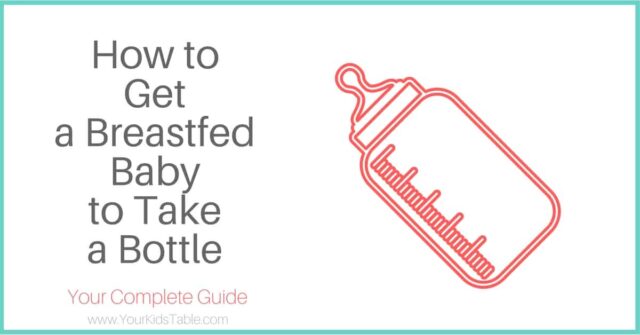
11 Tips for the Breastfed Baby Refusing a Bottle
1. Start early
I can bet that for most of you this ship has already sailed. Likely, if you're here reading, it's because you're already in a pickle, but if you happen to be reading this article in advance, I must tell you that I personally think it's tremendously helpful for parents to start offering a bottle within the second or even first week, if you want to be proactive.
However, I do want to mention that the Le Leche League recommends waiting longer before introducing.
But here's the thing, and I learned this lesson the hard way, for some babies, the bottle is often so foreign and confusing to a baby that they won't take to it. I'm fairly certain that is the main reason my oldest never took a bottle. I would suggest that if you do offer the bottle very early on, that you don't try again until the next day, you do want to keep breastfeeding as the primary means for feeding. Keep a close eye on how much you're using the bottle in these early days to not jeopardize breastfeeding!
2. Have someone else give the bottle (not you!)
Sounds simple, but it can make a HUGE difference. I was only able to give my second child a bottle a few times and my third would only take it from others, which was fine. Your baby can smell you and even though they are so tiny, they know that with you around, they can have what they prefer: YOU. This is a great opportunity for your partner or family members to bond feeding the baby. (That's my husband feeding James in the picture at the top!)
One caveat here though is that while you're trying to establish your baby taking the bottle, you may want to have someone with a little experience do the job, at least at first. My third son needed the motherly intuition and experience from my own mom to get started, even though my husband had fed our second child, he didn't know how to troubleshoot a bit to get his new son going. After my mom broke him in on a few bottles and gave him some tips for what was working, my husband and son did great.
3. Quiet please
Going to a quiet, non distracting, and relaxing location can make a huge difference. Before someone attempts to give your baby a bottle, have them go to this location for a few minutes and let them be rocked or swayed for a few minutes so they are nice and relaxed. In a calm and gentle approach, the bottle can be offered. This was a key trick that worked like a charm for my third baby. By the time he arrived, our house was pretty loud and chaotic with two older brothers, it was something I had taken for granted because this loud house was our normal and I thought a little baby wouldn't be bothered by it.

4. Find the magic, "just hungry enough" window
It may make sense to try and give your baby a bottle when they are starving. Common sense would lead us to believe that they are so desperate to eat at this point that surely they'll just give in and accept the bottle. This often does NOT work. Taking the bottle is a new experience for your baby, one they need to concentrate on and allow to happen. When they are starving, they just haven't got the time. A better time to try is when you can see they are hungry, but not starving.
You won't want to try too early though either, because if they aren't hungry enough, they won't be motivated to take it. It may take some experimenting, but finding the "just right" window of being hungry enough, but not too hungry could lead to bottle success.
5. Get them in position
While some babies do really well when they are held the exact same way to take a bottle as when you breastfeed them (and I'd definitely try that first), you will want to try different positions if that doesn't work. Think outside the box here, you never know what is going to work. My second son would sometimes like to take a bottle while facing outwards away from the bottle giver.
6. Leave the house
Yup, you may need to actually leave the house or at least go to another level of your home or lock yourself in a room for some time – that doesn't sound so bad, right? I wouldn't do this until you have had some bottle success. I tried this with my first son and just figured he and dad will figure it out. I came back from shopping 2 hours later to find them both exhausted and defeated. My husband had never given a baby a bottle before and I just left! Keep in mind that your baby hearing, seeing, and smelling you can sabotage anyone's attempts to give them a bottle.
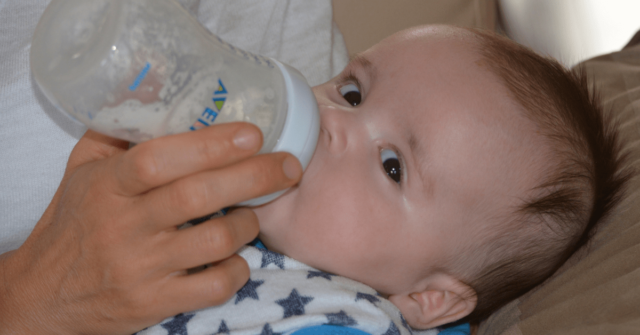
7. Try different bottles
Notice this is tip number 7! I think this is usually the first thing most moms try, and for good reason, but I would try the other suggestions first, before you spend a small fortune. However, there is something to be said for a bottle that your baby prefers. I'd recommend trying 1-2 bottles at a feeding time, and only purchasing 3-4 different types to use. You can find my favorite bottles for breastfed babies in the next section.
8. Experiment with flow
Sometimes you just need to change the nipple flow. Some babies need a really slow flow to accept a bottle and others may like something faster if you have a strong let down, as a slow flow nipple will just aggravate them. Just be careful of your babies age with a fast flow nipple because while they may prefer it, they may not be able to handle it. It takes a lot of coordination to swallow milk coming in quickly, and if they don't get it just right, they could aspirate, which is when liquid gets into their lungs – not a good thing.
9. Use a pacifier
I know that pacifiers get a very bad rap, especially in the breastfeeding community, and there are some really valid points, but when your baby is 4 months and under, a pacifier may help them get used to having something different being in their mouth. I wouldn't use it all the time, but if your baby seems bothered by the feeling of a bottle, a pacifier can help desensitize them when used a couple of times during the day.
10. Keep trying
Seems obvious, but it's so easy to throw in the towel, like I did with Sam. Using the tips above consistently over time can make a HUGE difference in your baby eventually taking a bottle! If it's important for your baby to take a bottle, then try once a day!
11. Worse case scenario – use a syringe, cup, or spoon
I will be totally honest and tell you that I have never used this technique, but I know, in some instances, it is necessary. I would only try this if all else fails and you are left with no other choice. Le Leche League has some great recommendations for alternative ways to get your baby fed here.
Affiliate links used below. See our full disclosure.
Best Bottles for Breastfeeding
There are dozens of bottle options out there, which can get overwhelming fast. Any one of them *may* work, but some tend to get the job done a little better when your baby is refusing. The following list are bottles that have worked in my home and/or some of the families that I've worked with.
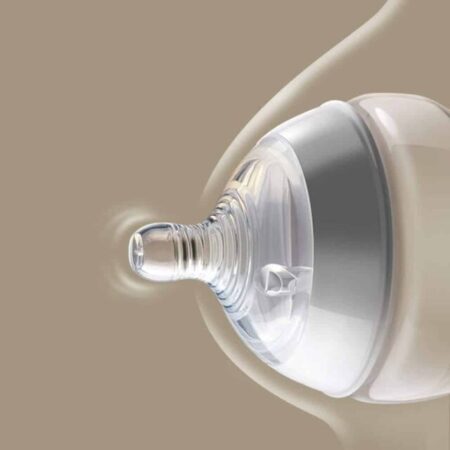
- Tommee Tipee (shown above) – These bottles designed for breastfeeding babies are my personal favorite and what I used with my second two sons, that actually took a bottle (I never tried this type with my oldest). They are affordable and have a stretchy nipple which replicates yours!
- Medela – I love these because you can go right from pumping to giving a bottle with little fuss if you have a Medela pump. We had some success with these in my home and I know many other families that have. These nipples have a much smaller base and some babies prefer that to the wider type bottles.
- Mimijumi – The Cadillac of breastfeeding bottles because they closely resemble the look and feel of a breast. I have personally never used these, but some of the families I've worked with have loved them.
- Dr. Brown's Wide Neck – Dr. Brown's bottles are popular, and for good reason. Their anti-gas system is built in and works great for a lot of colicky babies. I've known a lot of breastfeeding babies that accept these bottles and there's a special line designed for breastfeeding babies.
- Comotomo Natural Feel – These weren't even on my radar two years ago, but if they had been, I would have given them a try. This nipple and shape also mimics the breast, but they feature this really cool silicone bottom that's incredibly functional. There's a cool demo video on Amazon.
When the Time Comes to Stop Breastfeeding
I want to end this post with a resource for you about how to stop breastfeeding when you are ready. I'm not going to tell you when you should do that, but I will say I breastfed all my babies to 12-14 months old and it was a wonderful experience for me. The American Academy of Pediatrics (AAP) recommends 12 months of age, but for a variety of reasons, that isn't always possible. When you and your baby are ready, you'll want to head over to my Stopping Breastfeeding How-To post. If you're nowhere ready for that, make sure you pin it for later!
Now that you have a few tricks up your sleeve to get your breastfed champ taking a bottle, too, make sure you stop back and let me know what worked. And if you have any other tips, PLEASE share them, so many people read the comments and you just never know who you will be helping!
Did you pin it?
This is the kind of post you're probably going to want to reference again, pin it, so you know just where to find it!
Looking for more?
I've got you covered, from all things kids and eating and sensory. Grab my Guide to Good Eating Habits in Kids (which can also be used to improve eating). Sign up here!
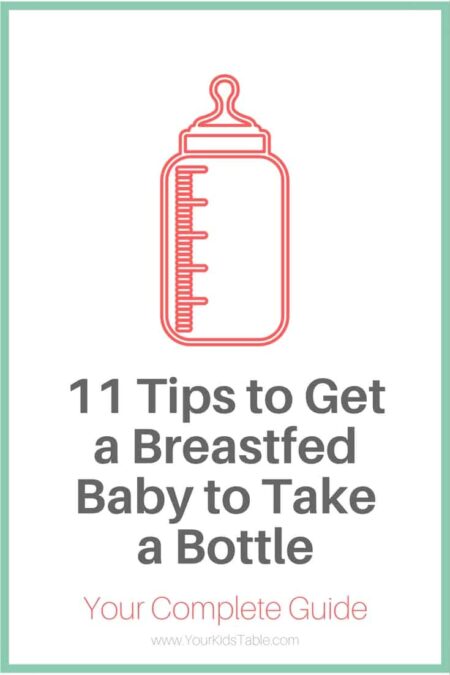
Alisha Grogan is a licensed occupational therapist and founder of Your Kid's Table. She has over 14 years experience with expertise in sensory processing and feeding development in babies, toddlers, and children. Alisha also has 3 boys of her own at home. Learn more about her here .
How Long Does It Take for Baby to Adjust to Formula Change
Source: https://yourkidstable.com/my-baby-wont-take-a-bottle/
0 Response to "How Long Does It Take for Baby to Adjust to Formula Change"
Post a Comment